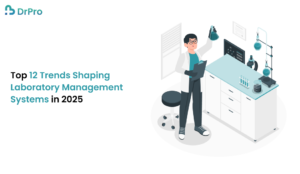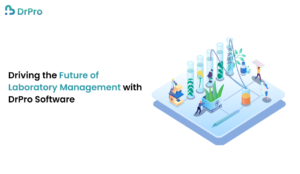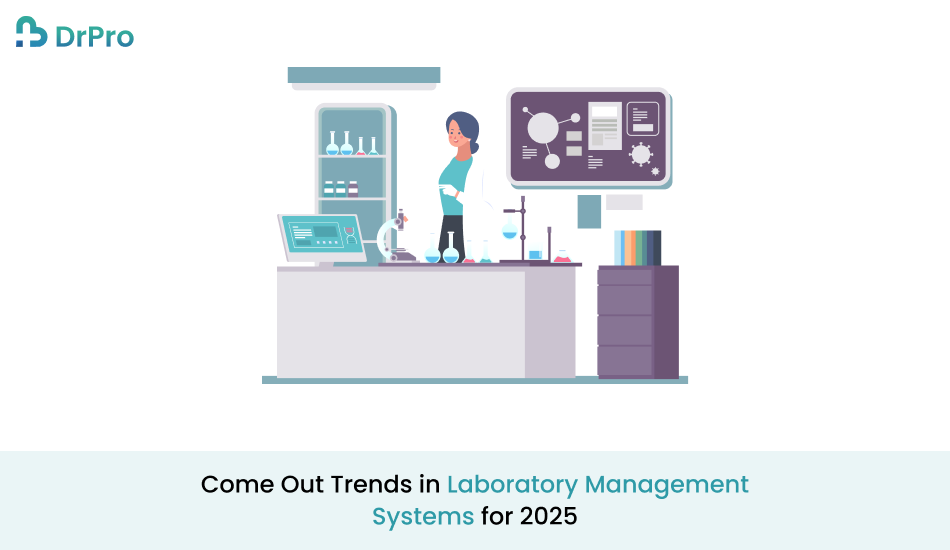The healthcare and laboratory industries are experiencing exciting evolutions from technology, changing rules, and rising expectations for health improvement. LMS stands for Laboratory Management Systems and has emerged to be a tool of great importance in the center to become competitive, productive, and reliable. Taking into consideration the year 2025, it is possible to state that tendencies in laboratory management are lean on automation, integration, and intelligence. It opens up a whole new way of thinking about lab technologies and how these technologies are not just enhancing the operations of labs but also in a way helping to meet the patient’s care needs more effectively, accurately, and sustainably.
In this article, we will consider further development of Laboratory Management Systems for the year 2025 and the tendencies predicting it. This will also examine how the various change factors are being brought about and the role of DrPro’s laboratory management software in enhancing the operational operations of the labs.
What is a Laboratory Management System (LMS)?
A Laboratory Management System also known as LMS is an integrated tool that helps in the automation and efficient handling of laboratory daily business. Automated tasks it can assist with include sample tracking and management, inventory, data management, reporting, compliance with respective legislations, and interfacing with other systems common in healthcare such as the Electronic Health Record (EHR) and Hospital Information System (HIS).
An LMS enables a laboratory to run efficiently, and provide technicians, lab managers, and clinicians with real-time data that enhances the performance of analysis, minimizes errors, and achieves high quality and accreditation standards. In a business environment where such qualities as precision, speed, and proven conformity are critical for an organization’s laboratory, an LMS comes in handy.
Top 12 Trends Shaping Laboratory Management Systems in 2025

1. Artificial Intelligence and Machine Learning Integration
AI and ML are fully integrated into Laboratory Management Systems and their functions, including decision support through predictive analytics and process automation. Through the use of AI, these tools can assist the labs in analyzing larger quantities of data than the conventional methods would offer.
- Use Case Example: It is always possible to assess the potential results of lab tests, corresponding to previous records, it can recommend possible diseases or abnormalities and point at suspicious results.
- Impact: Better, quicker, more precise outcomes with less human intervention, and streamlines processes that improve lab workers’ time on more important tasks.
2. Increased Automation of Routine Tasks
Automations in laboratories have begun and are gradually increasing to wash out the manual interactions and increase the preciseness of methods alongside the duration taken. Some of the activities including sample identification, processing, and entry of results are already being partially computerized in a bid to reduce human interferences.
- Example: Nowadays, sample sorting in an automatic mode, barcode scanning, and data entry are performed by computerized systems.
- Impact: Labs benefit from increased automation since they can store, process, and analyze more samples and tests, at a lower cost and with fewer errors than manual labor.
3. Integration with IoT-Enabled Devices
The Internet of Things (IoT) enables laboratory equipment and devices to enter into LMS platforms to enable the laboratory staff to monitor the working conditions/ efficiency of different machines that are in use in the laboratory in real mode. Some exciting features of Laboratory Management Systems IoT include monitoring instances when equipment requires maintenance or any variation in the test conditions.
- Example: Temperature, humidity, and equipment sensors can also be used to alert staff members to changes to certain parameters that are undesirable.
- Impact: Connected IoT within laboratories controls for equipment breakdown that hinders lab order and accurate test outcomes.
4. Cloud-Based Laboratory Management Solutions
The number of Cloud-based Laboratory Management Systems? Implementation is increasing due to the flexibility cost-effectiveness and scalability of the service. These systems afford labs the mechanism of accessing as well as managing their data off-site, which is vital for labs with satellite stations/branches and/or those with huge data sets.
- Benefits: Solutions that are based on the cloud do not require local hardware and are costlier than locally hosted versions, enable multiple employees to work within one project simultaneously, and do not require locally installed software to be accessible at any time.
- Impact: This change also aids labs in minimizing their expenditures while making results more accessible and building a more efficient framework thereupon.
5. Enhanced Data Analytics and Reporting
In 2025, several LMS platforms have also integrated a large number of data analytics and reporting features. These tools give information concerning the laboratory seeks, test tendencies, inventories, and patients to assist the managers in their decision-making process.
- Example: The lab managers can then determine shifts that have records of performing tests frequently and then consider improving the staff schedules.
- Impact: Through the application of analytics, labs increase efficiency and productivity in organizational processes, and enhance patients’ outcomes and support.
6. Real-Time Sample Tracking
Sample tracking enables the laboratory staff to monitor the exposure of samples during their handling and testing, from the time they were collected to the time they are tested and the results obtained are available. This feature assists in ascertaining that samples for laboratory acceptance undergo processing without undue drudgery.
- Example: Barcodes or RFID tags on samples enhance the tracking capabilities of the LMS for the lab staff since each sample’s physical location is known at all times.
- Impact: This reduces the chances of losing samples in the process, enhances the speed of testing, and equally ensures that the samples are properly handled.
7. Improved Inventory Management
Inventory is one of the most crucial aspects to be managed efficiently in any laboratory since some of the laboratory consumables are expensive while others are scarce, such that an organization doesn’t want to be in a situation of running out of stock. Today’s LMS solutions are provided with relevant inventory management subsystems which help labs to monitor the current state of stocks, reorder supplies, and forecast future requirements based on usage trends.
- Example: With reagents, test kits, and consumable inventory management being in real-time, the labs are supplied with what they require at any given time without having to stockpile which can be expensive.
- Impact: The laboratory can cut costs and waste while being aware of what is in its availability so that it can operate continuously without disruption.
8. Regulatory Compliance and Data Security
There is a constant upsurge in the rules that pertain to the operations of a laboratory, and therefore compliance is more crucial today than before. Forecasted, LMS platforms in 2025 will also contain compliance features such as audit trails, role-based access control, and data that will be encrypted.
- Example: There will be data encryption for patient data where an LMS is HIPAA and GDPR-compliant allowing for patient data protection.
- Impact: The automatic tracking of compliance helps the labs to meet the regulatory requirements thus avoiding penalties and company reputation loss.
9. Interoperability with Other Healthcare Systems
Modern LMS platforms are integrating more with other healthcare systems like EHR, HIS, or pharmacy management systems. This integration enables the dense sharing of data between labs, hospitals, and pharmacists and thus enhances patient care and clinical operations.
- Example: If labs are completed using the Laboratory Management System, the results go directly into a patient’s EHR to provide to physicians for immediate use in decision-making.
- Impact: This integrated model minimizes situations where there is repeated testing, fosters better results, and speeds up treatment plans.
10. Focus on Personalized Medicine
Care of the patient that takes into account the features inherent in the patient is one of the increasingly common tendencies in the sphere of medicine. Today’s labs are expected to deliver information that can inform specific treatment regimens. LMS platforms have been cited as shifting towards accommodating other individual health knowledge including the genetic, biomarkers, and other holistic interior data.
- Example: LMS incorporates genomic data analysis whereby labs can determine the genetic factors that affect the patient’s response to therapies he or she is receiving.
- Impact: If one focuses on laboratories, it is possible to get more specific results and assist clinicians in planning the necessary individual treatment.
11. Mobile-First Access
Mobile-first Laboratory Management System solutions are built to enable laboratory staff to obtain data and perform tasks directly from their mobile devices. This trend is very helpful for the lab manager who wants to oversee the processes going on in the laboratory and also wants to make sure that everything is going fine from his end.
- Example: End-users of the lab, including test results or equipment malfunction alerts, can be passed to the respective staff on their portable device for quick and off-site action to be taken.
- Impact: Anytime support increases adaptability where lab specialists can work from any location.
12. Sustainability and Green Practices
The consideration of sustainability is already emerging as an important topic in the global healthcare industry, and thus LMSs are not immune to it. Most laboratories are incorporating environmentally friendly approaches like minimizing waste, using energy efficiently, and incorporating environmentally friendly products.
- Example: Laboratory Management System platforms are being used to monitor energy consumption, conserve chemicals, and general resource consumption by the labs.
- Impact: It ensures that costs are cut down, environmental effects are minimized, and reasonably useful as a strategy for attaining global sustainability standards.
Driving the Future of Laboratory Management with DrPro Software

At DrPro, we know well that the future of laboratories lies in the application of sophisticated technologies that will enhance productivity and patient outcomes. Our Laboratory Management System is built with these trends in mind, offering features such as:
- AI-Driven Analytics: Our system integrates the functionality of artificial intelligence technology to analyze your laboratory data to increase your probability of making the right decision at the right time.
- Cloud-Based Access: Make it possible to access your lab’s data anywhere and at any time using cloud-hosted solutions.
- Seamless Integration: The lab results in our Laboratory Management System are easily accessible to clinicians since the software we use in the online lab system works in conjunction with EHR, HIS, and other applications in the healthcare field.
Through adopting DrPro’s Laboratory Management System your laboratory can: Work more efficiently; minimize mistakes and incidences of non-compliance and ultimately enhance the overall patient care you provide to your clientele.
Conclusion
Now and towards 2025, LIMS is evolving, with general trends like Automation, Artificial Intelligence, Cloud Solutions, and Interoperability playing out throughout the healthcare sector. Such systems are revolutionizing the working of these labs and bringing more connected and patient-proximal processes to them. Through implementing these trends and utilizing such effective LMS solutions as DrPro the laboratories maintain high competitor levels while providing the maximum level of patients’ services.
FAQs
Q1. What is the main benefit of using an LMS in a laboratory?
The main benefit of using an LMS is the improvement in efficiency and accuracy. It helps automate routine tasks, track samples, manage inventory, and ensure compliance, leading to faster, more reliable results.
Q2. How does AI improve laboratory operations?
AI can analyze large amounts of data, predict outcomes, identify anomalies, and optimize workflows, all of which contribute to faster and more accurate testing and reporting.
Q3. What is the importance of data security in laboratory management?
Data security is crucial to protect patient information and ensure compliance with regulations like HIPAA. A Laboratory Management System with robust security features ensures that sensitive data is encrypted, secure, and accessible only to authorized personnel.
Q4. Can a Laboratory Management System integrate with other healthcare systems?
Yes, most modern Laboratory Management System platforms, including DrPro’s, are designed to integrate seamlessly with Electronic Health Records (EHR), Hospital Information Systems (HIS), and other healthcare systems, promoting efficient data sharing and collaboration.
Q5. How can labs benefit from mobile access to their LMS?
Mobile access allows lab staff to monitor operations, receive alerts, and manage workflows remotely, increasing flexibility and enabling faster responses to issues that may arise.


